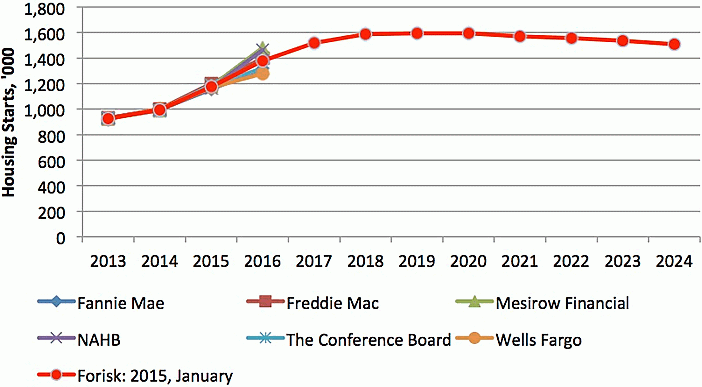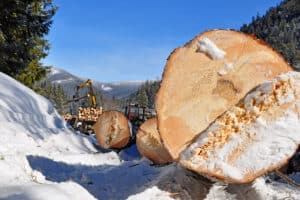Anytime we look to predict the outcome of a Super Bowl in football or World Series in baseball, we look at history and physical facts. How did teams and individuals perform over the past year in different situations? Who is bigger, faster, stronger and, most critically, healthy and available to play ball? When forecasting timber prices and wood costs, we have a similar approach.
Projecting forestry markets includes (1) identifying and understanding relationships in historical data and (2) quantifying the “physical facts” on the ground in local markets related to supplies and capacity. We also use “sensitivity analysis” to test the relative importance of inputs in our models to ground our results in the real world. Is this assumption credible? Is that assumption viable? The process clarifies our understanding of the relationship between wood costs, timber prices and North American softwood lumber production.
Housing Markets for 2015
Looking forward, what do we assume for US housing markets? Forisk’s Housing Starts Outlook combines independent forecasts from professionals in the housing industry. Currently, these include Fannie Mae, Freddie Mac, Mesirow Financial, the National Association of Home Builders (NAHB), The Conference Board, and Wells Fargo, as well as long-term assumptions from the Congressional Budget Office (CBO).
Forisk’s 2015 Base Case peaks at 1.60 million housing starts in 2019 before returning to a long-term trend approaching 1.51 million. For comparison, our August 2014 Base Case peaked at 1.58 million housing starts in 2019. Overall, Forisk’s housing start projections total 1.176 million for 2015.
Forisk Research Quarterly (FRQ) Q1 2015 US Housing Starts Outlook, Base Case

Sensitivity of Housing and Softwood Lumber Production
Three key sources supply most softwood lumber used in the United States: the U.S. South, the Pacific Northwest, and Canadian imports. These three account for 95% of the softwood lumber consumed in the United States. So how we view the capacity and production – the availability and health – of softwood lumber mills in each region critically affects our view of future timber prices and wood costs relative to actual housing starts.
Forisk’s Base Case assumes 1.176 million housing starts in the U.S. This corresponds to an estimated 46.08 billion board feet of softwood lumber consumption, an increase of 7.5% over 2014. If housing starts approach 1.3 million in 2015 instead of 1.2 million (you never know), this would require an additional 1.5-1.8 billion board feet of softwood lumber. To fill this demand, production in the U.S. South, instead of increasing 8.5% would need to grow production over 14% above 2014. Alternately, a slower housing market, one that hovers below 1.1 million housing starts, depresses wood demand and timber price growth.
Then consider imports. If Canada can import an additional 1 billion board feet of softwood lumber above and beyond the Forisk Base Case, Southern sawmills would only need to increase softwood lumber production by 5% over 2014. This would benefit sawmill wood costs and depress timberland investment returns.
Part of “inferring future conditions” requires framing an economic context. Prioritizing assumptions provides context. Housing starts, while the most critical of all factors, do not drive softwood lumber demand and production in a vacuum; rather, housing starts serve to proxy overall economic activity. Over 90% of softwood lumber demand relies on three core markets: home construction, repair and remodeling (R&R) and industrial applications. In the end, key inputs remain sequential, with demand the necessary catalyst driving timber prices and forest investment performance.
This content may not be used or reproduced in any manner whatsoever, in part or in whole, without written permission of LANDTHINK. Use of this content without permission is a violation of federal copyright law. The articles, posts, comments, opinions and information provided by LANDTHINK are for informational and research purposes only and DOES NOT substitute or coincide with the advice of an attorney, accountant, real estate broker or any other licensed real estate professional. LANDTHINK strongly advises visitors and readers to seek their own professional guidance and advice related to buying, investing in or selling real estate.










This is a great article! We have to also take into consideration the SLA duties as well as the USD/CAD (also the USD/EUR exchange rates and then of course, there’s China.(Shrinking demand for logs and lumber?)
We were hit hard by the burst of the bubble here in SWFL and our home starts for last month were close to before burst levels! A very welcome sign indeed!